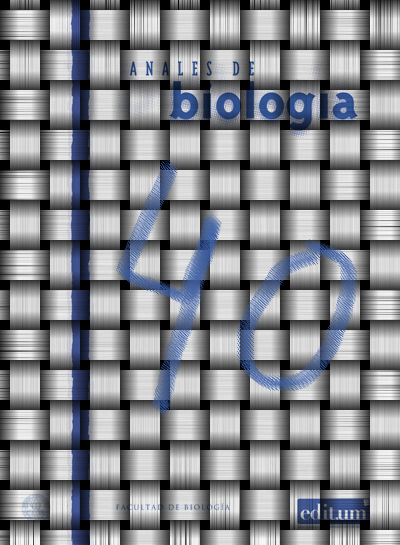Repellent Activity of the essential oil of Bursera graveolens Jacq. ex L., against Tribolium castaneum Herbst, 1797 (Coleoptera: Tenebrionidae)
Abstract
Tribolium castaneum (Herbst, 1797) is a plague that infest store products, mainly grains. One alternative to control it is the use of natural products, highlighting the essential oils. It was evaluated the repellent activity of the essential oil of Bursera graveolens Jacq. ex L. towards T. castaneum. Results shows significant differences (p<0.005) between the treated area and the non trated area at 0.02, and 0.2 µL/cm2 doses after two hours of exposition. Repellent activity decreased when the time of exposition increased. In conclusión, the essential oil of B. graveolens could be an effective repellent against plague insects, being also this report the first related to repellency in this plant.
Downloads
References
Aldana-Llanos L, Salinas-Sánchez DO, Valdés-Estrada ME, Gutiérrez-Ochoa M & Valladares-Cisneros MG. 2010. Evaluación bioinsecticida de extractos de Burseracopallifera (D.C.) Bullock y Burseragrandifolia (Schltdl.) Engl. en gusano cogollero Spodopterafrugiperda J.E. Smith (Lepidoptera: Noctuidae). Polibotánica 29: 149-158.
Becerra J. 2007. The impact of herbivore-plant coevolution on plant community structure. Proceedings of the National Academy of Sciences of USA 104(18): 7483-7488.
Becerra J, Venable D, Evans P & Bowers W. 2001. Interactions Between Chemical and Mechanical Defenses in the Plant Genus Bursera and Their Implications for Herbivores1. American Zoologist 41(4): 865-876.
Caballero-Gallardo K, Pino-Benitez N, Pajaro-Castro N, Stashenko E & Olivero-Verbel J. 2014. Plants cultivated in Choco, Colombia, as source of repellents against Tribolium castaneum (Herbst) Journal of Asia-Pacific Entomology 17(4): 753-759.
Caballero K, Olivero-Verbel J & Stashenko E. 2012. Repellency and toxicity of essential oils from Cymbopogon martinii Cymbopogon flexuosus and Lippia organoides cultivated in Colombia against Tribolium castaneum. Journal of Stored Products Research 50: 62-65.
Carretero M, López-Pérez J, Abad M, Bermejo P, Tillet S, Israel A & Noguera-P B. 2008. Preliminary study of the anti-inflammatory activity of hexane extract and fractions from Bursera simaruba (Linneo) Sarg. (Burseraceae) leaves. Journal of Ethnopharmacology 116(1): 11-15.
Daly D. 1993. Notes on Bursera in South America, including a new species. Studies in Neotropical Burseraceae VII. Brittonia 45(3): 240-246.
Descamps L, Stefanazzi N, Sanchez Chopa C & Ferrero A. 2008. Actividad biologica de extractos vegetales de schinus molle var. areira (anacardiaceae) en Tribolium castaneum Herbst. ) insecta,(coleoptera, Tenebrionidae), plaga de grano almacenado. Boletín de sanidad vegetal. Plagas 34: 595- 605.
Hernandez-Lambraño R, Pajaro-Castro N, Caballero-Gallardo K, Stashenko E & Olivero-Verbel, J. 2015. Essential oils from plants of the genus Cymbopogon as natural insecticides to control stored product pests. Journal of Stored Products Research 62: 81-83.
Kaushik P & Kaushik G. 2007. An assessment of structure and toxicity correlation in organochlorine pesticides. Journal of Hazardous Materials 143(1-2): 102-111.
Landau-Ossondo M, Rabia N, Jos-Pelage J, Marquet L, Isidore Y, Saint-Aimé C & Belpomme D. 2009. Why pesticides could be a common cause of prostate and breast cancers in the French Caribbean Island, Martinique. An overview on key mechanisms of pesticide-induced cancer. Biomedicine & Pharmacotherapy 63(6): 383-395.
Li H, Chen C & Cao X. 2015. Essential oils-oriented chiral esters as potential pesticides: Asymmetric syntheses, characterization and bio-evaluation. Industrial Crops and Products 76: 432-436.
Licciardello F, Muratore G, Suma P, Russo A & Nerín C. 2013. Effectiveness of a novel insect-repellent food packaging incorporating essential oils against the red flour beetle (Tribolium castaneum). Innovative Food Science & Emerging Technologies 19: 173-180.
Maldini M, Montoro P, Piacente S & Pizza C. 2009. Phenolic compounds from Bursera simaruba Sarg. bark: phytochemical investigation and quantitative analysis by tandem mass spectrometry. Phytochemistry 70(5): 641-649.
McDoniel P & Cole J. 1972. Antitumor activity of Bursera schlechtendalii (burseraceae): isolation and structure determination of two new lignans. Journal of Pharmaceutical Sciences 61(12): 1992-1994.
Nenaah, G. 2014. Chemical composition, toxicity and growth inhibitory activities of essential oils of three Achillea species and their nano-emulsions against Tribolium castaneum (Herbst). Industrial Crops and Products 53: 252-260.
Nerio Quintana L, Olivero-Verbel J & Stashenko E. 2009. Repellent activity of essential oils from seven aromatic plants grown in Colombia against Sitophilus zeamais Motschulsky (Coleoptera) Journal of Stored Products Research 45: 212-214
Noge K, Lawrence Venable D & Becerra J. 2011. 2-Phenylethanol in the leaves of Bursera velutina Bullock (Burseraceae). Acta botánica mexicana 97: 9-16.
Olivero-Verbel J, Tirado-Ballestas I, Caballero-Gallardo K & Stashenko E. 2013. Essential oils applied to the food act as repellents toward Tribolium castaneum. Journal of Stored Products Research 55(0): 145-147.
Rey-Valeirón C, Guzmán L, Saa L, López-Vargas J & Valarezo E. 2017. Acaricidal activity of essential oils of Bursera graveolens (Kunth) Triana & Planch and Schinus molle L. on unengorged larvae of cattle tick Rhipicephalus (Boophilus) microplus (Acari:Ixodidae). Journal of Essential Oil Research 29(4): 344-350.
Rosas-Arreguín P, Arteaga-Nieto P, Reynoso-Orozco R, Villagómez-Castro J, Sabanero-López M, Puebla-Pérez A & Calvo-Méndez C. 2008. Bursera fagaroides, effect of an ethanolic extract on ornithine decarboxylase (ODC) activity in vitro and on the growth of Entamoeba histolytica. Experimental Parasitology 119(3): 398-402.
Sánchez Alejo E. 2001. Selección y caracterización de cepas de Bacillus thuringiensis tóxicas contra Tribolium castaneum (Coleoptera: Tenebrionidae) (Herbst) y Oryzaephilus surinamensis (L.) Nuevo León: Universidad Autónoma de Nuevo León. Tesis Doctoral.
Souza Tette P, Rocha Guidi L, de Abreu Glória M & Fernandes C. 2016. Pesticides in honey: A review on chromatographic analytical methods. Talanta. 149: 124-141.
Tapondjou A, Adler C, Fontem D, Bouda H & Reichmuth C. 2005. Bioactivities of cymol and essential oils of Cupressus sempervirens and Eucalyptus saligna against Sitophilus zeamais Motschulsky and Tribolium confusum du Val. Journal of Stored Products Research. 41(1): 91-102.
Torrenegra M, Clemente G, Osorio M & León G. 2014. Comparación de la Hidro-Destilación asistida por radiación de microondas (MWHD) con hidrodetilación convencional (HD) en la extracción de aceite esencial de Mintostachys mollis. Información Tecnológica. 26 2015:117-118.
Torres Almijos C, Ojeda S & Gonzalez S. 2012. Desarrollo de una crema repelente a partir del aceite esencial de la especie Bursera Graveolens (palo santo). Ecuador: Universidad técnica particular de Loja.press.
Utono I, Coote C & Gibson G. 2014. Field study of the repellent activity of ‘Lem-ocimum’-treated double bags against the insect pests of stored sorghum, Tribolium castaneum and Rhyzopertha dominica, in northern Nigeria. Journal of Stored Products Research. 59: 222-230.
Vacacela M & Ojeda S. 2012. Diseño y desarrollo de una loción repelente a partir del aceite esencial de la especie palo santo (Bursera graveolens). Ecuador. Universidad Tecnica particular de Loja.press.
Yazdgerdian A, Akhtar Y & Isman M. 2015. Insecticidal effects of essential oils against woolly beech aphid, Phyllaphis fagi (Hemiptera: Aphididae) and rice weevil, Sitophilus oryzae (Coleoptera: Curculionidae). Journal of Entomology and Zoology Studies. 3(3):265-271.
You C, Zhang W, Guo S, Wang C, Yang K., Liang J, Deng Z. 2015. Chemical composition of essential oils extracted from six Murraya species and their repellent activity against Tribolium castaneum. Industrial Crops and Products. 76: 681-687.
Yukawa C & Iwabuchi H. 2003. Terpenoids in Volatile Oil from Bursera graveolens Journal of oleo science 52(9):483-489
Zapata N & Smagghe G. 2010. Repellency and toxicity of essential oils from the leaves and bark of Laurelia sempervirens and Drimys winteri against Tribolium castaneum. Industrial Crops and Products. 32(3): 405-410

This work is licensed under a Creative Commons Attribution-NonCommercial-NoDerivatives 4.0 International License.
Las obras que se publican en esta revista están sujetas a los siguientes términos:
1. El Servicio de Publicaciones de la Universidad de Murcia (la editorial) conserva los derechos patrimoniales (copyright) de las obras publicadas, y favorece y permite la reutilización de las mismas bajo la licencia de uso indicada en el punto 2.
2. Las obras se publican en la edición electrónica de la revista bajo una licencia Creative Commons Reconocimiento-NoComercial-SinObraDerivada 3.0 España (texto legal). Se pueden copiar, usar, difundir, transmitir y exponer públicamente, siempre que: i) se cite la autoría y la fuente original de su publicación (revista, editorial y URL de la obra); ii) no se usen para fines comerciales; iii) se mencione la existencia y especificaciones de esta licencia de uso.
3. Condiciones de auto-archivo. Se permite y se anima a los autores a difundir electrónicamente las versiones pre-print (versión antes de ser evaluada) y/o post-print (versión evaluada y aceptada para su publicación) de sus obras antes de su publicación, ya que favorece su circulación y difusión más temprana y con ello un posible aumento en su citación y alcance entre la comunidad académica. Color RoMEO: verde.











